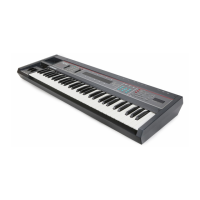
Do you have a question about the ENSONIQ SQ-80 and is the answer not in the manual?
| Polyphony | 8 voices |
|---|---|
| Storage | Floppy disk |
| MIDI | In, Out, Thru |
| Year Released | 1988 |
| Type | Digital |
| Timbrality | 8 |
| Waveforms | Digital samples |
| Filter | Analog resonant low-pass filter |
| LFO | 1 LFO |
| Effects | Chorus |
| Keyboard | 61 keys |
| Memory | 64 patches |
| Outputs | Stereo |
Instructions for connecting the power cable and turning on the SQ-80.
Explanation of AC line voltage sensitivity and protection options.
Guide on connecting the SQ-80 to audio systems and amplifiers.
Details on connecting audio outputs for mono, stereo, and headphone use.
Information on connecting an optional Control Voltage Foot Pedal for modulation.
Description of the Tape In jack for sync tracks and data loading.
Identifies key controls: Display, buttons, slider, and arrow buttons.
Explanation of Master Banks (Internal, Cart A, Cart B) for organizing sounds.
Details on using Bank Select buttons to navigate through programs.
Description of the page-driven editing system using Data Entry Slider.
Explains how display configurations are called 'Pages'.
Defines the function-dependent buttons above and below the display.
Procedure for adjusting parameter values using slider and arrow buttons.
Explains reinitialization as a system reboot for the SQ-80.
Reasons for reinitializing due to software or data corruption.
Step-by-step instructions for performing a factory reinitialization.
Controls global settings like tuning, keyboard touch, and MIDI modes.
Manages MIDI channel, overflow, external controller, and pressure settings.
Details on digital wave memory, including waveforms, inharmonic loops, and transient attacks.
Explains how modulation sources affect parameters like pitch, volume, and filter.
Overview of pages for editing program parameters like OSC, DCA, FILTER, LFO, ENV, MODES.
Explains MIDI as a standard for musical event translation.
Describes how sequencers record and manage musical data as events.
Defines Sequences as patterns and Songs as chains of Sequences.
Details on buttons for starting, stopping, and recording sequences.
Explains states like STOP, PLAY, REC, and ODUB.
Functions for editing individual tracks: Transpose, Remove Controllers, Quantize, Erase, Merge.
Functions for editing entire sequences: Append, Add Bars, Delete Bars, Copy.
Function for transferring programs between internal memory and cartridges.
Guide to saving and loading data using the SQ-80's disk drive.
Operations for managing disk files: Format, Save, Load, Delete, Copy.
Procedure for saving and loading MIDI System Exclusive data.
Instructions for sending Program and Sequencer data via MIDI.
Information on saving and loading data using audio tape.
List of MIDI program numbers corresponding to internal and cartridge programs.
Technical details of the SQ-80's MIDI implementation and message formats.
A comprehensive list of SQ-80 parameters with their corresponding numbers.
Summary chart of MIDI functions, transmitted, recognized, and remarks.
Diagrams illustrating the internal structure of program control blocks.
Details on the keyboard's action, sensitivity, and features.
Description of the voice architecture, oscillators, waveforms, and modulation.
Information about the display, programming interface, and program access.
Details on tracks, quantization, auto-locator, metronome, and sequences/songs.
Overview of MIDI modes, overflow, controllers, and song position pointers.
Specifications for disk drive capacity and storage formats.
List of audio, headphone, pedal, and MIDI connections.
Included accessories like manual, power cord, and pedals.
List of available optional accessories for the SQ-80.
Physical dimensions and weight of the SQ-80 unit.
Information regarding the product's warranty terms.
General safety precautions for using electrical products.